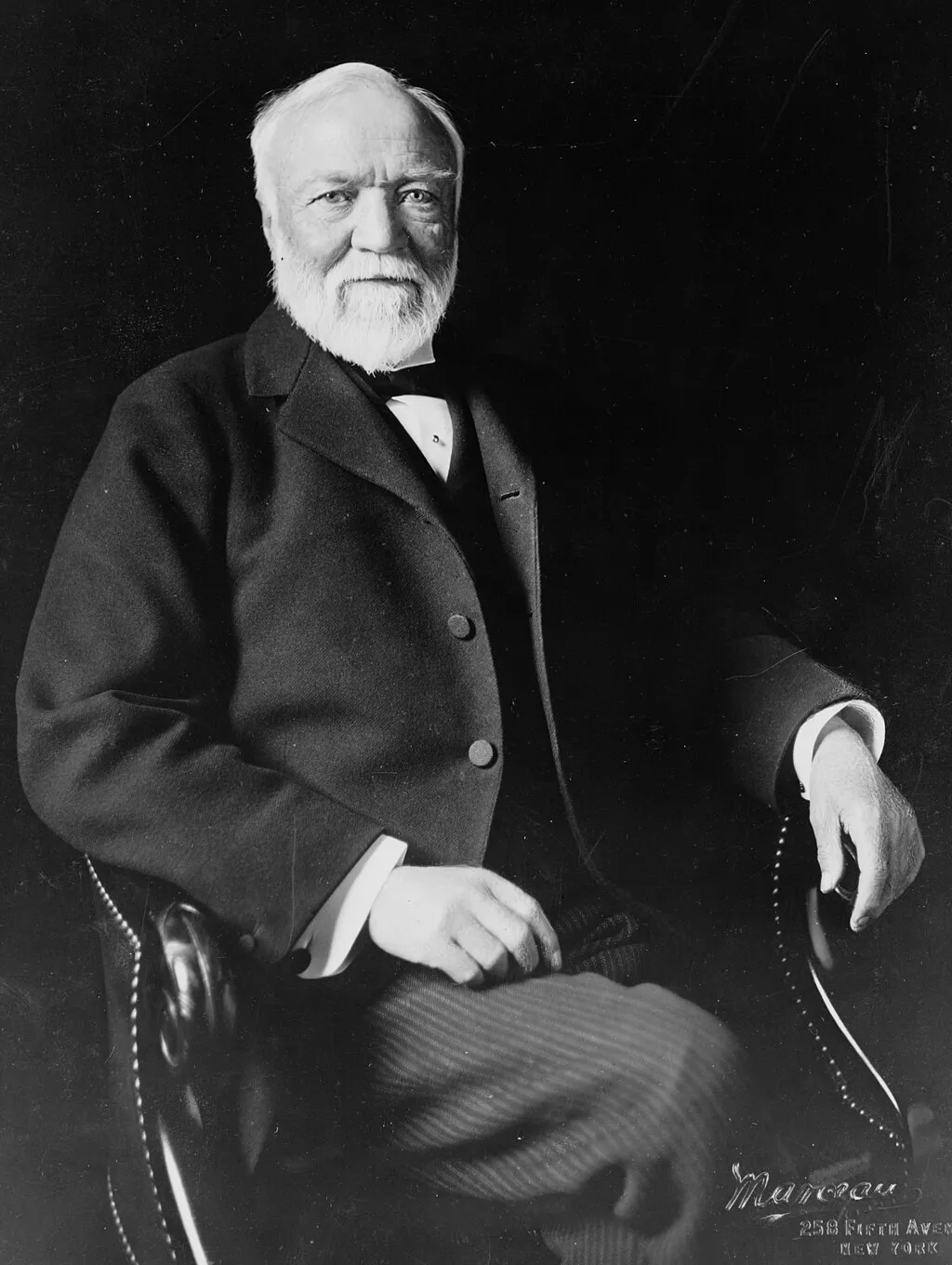Andrew Carnegie's story begins in the modest town of Dunfermline, Scotland, where he was born into a life of severe poverty on November 25, 1835. His family’s situation was dire, with his father, William Carnegie, working as a handloom weaver, and his mother, Margaret Morrison Carnegie, sewing shoes to make ends meet. The advent of steam-powered looms rapidly put William out of business, as his traditional weaving methods became obsolete. This technological shift devastated their livelihood, leaving the family struggling to survive.
The Carnegies lived in a small, cramped cottage, reflecting the harsh realities of their economic status. Andrew's parents worked tirelessly, but their combined efforts barely kept the family afloat. Despite the relentless hardship, Margaret was determined to provide for her children. She was the bedrock of the family, instilling in Andrew the values of perseverance and hard work that would later define his path to success.
The young Andrew attended school for only a few years, as financial pressures forced him to leave and contribute to the family’s income. This lack of formal education did not deter his hunger for knowledge. Instead, he became an avid reader, borrowing books whenever possible and learning as much as he could from the world around him.
The dire circumstances of his upbringing left a profound impact on Carnegie. Witnessing his father's struggles and the relentless efforts of his mother to support the family shaped his views on industry and labor. These early experiences in Scotland laid the foundation for his relentless drive and ambition, setting the stage for his eventual rise to become one of the wealthiest and most influential figures in history.
Emigration to America
In 1848, driven by the unyielding economic hardships in Scotland, the Carnegie family made the bold decision to emigrate to America in search of a better life. They sold all their possessions and borrowed £20 to afford the passage across the Atlantic. Andrew, just 12 years old, embarked on this journey with his parents and younger brother, full of hope and apprehension.
The Carnegies settled in Allegheny, Pennsylvania, now part of Pittsburgh, a bustling hub of manufacturing and industry. Despite the promise of the "land of opportunity," their struggles continued. Both of Andrew's parents found it difficult to secure stable work. His father took up various jobs, but none provided the stability needed. Margaret, ever resourceful, took on work as a seamstress and managed a small grocery shop, displaying remarkable resilience.
To help support his family, Andrew was forced to leave school and enter the workforce. His first job was in a cotton factory, where he earned a meager $1.20 per week. This job was grueling and offered little in terms of prospects. However, a turning point came when he landed a position as a messenger boy at the Ohio Telegraph Company. This job, though modest, opened a window into a larger world.
Andrew quickly distinguished himself with his hard work, keen memory, and eagerness to learn. He memorized the faces and names of important businessmen in Pittsburgh, which helped him build a network of influential contacts. His determination and industriousness caught the attention of his superiors, setting the stage for his next big opportunity in the railroad industry. This early job was the first step on a path that would eventually lead to immense wealth and success, demonstrating his unwavering commitment to improving his circumstances.
Railroad Industry
Andrew Carnegie's life took a significant turn in 1853 when, at the age of 18, he was offered a position with the Pennsylvania Railroad Company, thanks to his diligent work as a telegraph messenger. Thomas A. Scott, a regional manager for the company, recognized Carnegie's potential and hired him as his personal telegrapher and private secretary, paying $35 a month—a substantial salary at the time.
This position was a golden opportunity for young Carnegie. Under Scott's mentorship, he gained invaluable insights into the railroad industry, which was the backbone of America’s industrial growth. Scott became a father figure to Carnegie, teaching him the intricacies of business operations, management, and investments. This hands-on experience provided Carnegie with a front-row seat to the complexities of running a major corporation.
Scott's influence extended beyond professional mentorship. He encouraged Carnegie to invest in the Adams Express Company, a venture that transported goods and valuables across the country. Following Scott’s advice, Carnegie made his first investment, marking the beginning of his journey into capitalism. This initial investment was successful, and the profits ignited his passion for business and investments.
During his tenure with the railroad, Carnegie was instrumental in managing logistics and expanding the network. He displayed an exceptional ability to identify inefficiencies and implement solutions, further proving his business acumen. This period also introduced him to the power of leveraging connections and opportunities, a skill that would serve him well throughout his career.
Carnegie's breakthrough in the railroad industry was more than just a job; it was a transformative phase that equipped him with the knowledge, skills, and connections necessary to embark on future ventures. It laid the foundation for his subsequent success in various industries, particularly in steel, and set him on the path to becoming one of the wealthiest men in the world.
Wartime Profits and the Keystone Bridge Company
During the American Civil War, Andrew Carnegie astutely leveraged his railroad experience and connections to profit from the turmoil. Instead of serving in the Union Army, he paid $850 for a substitute to take his place, allowing him to continue focusing on business opportunities. This controversial decision underscored his pragmatic approach to his career.
One of Carnegie's key observations during the war was the vulnerability of wooden bridges, which were easily destroyed by fire. Recognizing a significant opportunity, he pivoted towards the iron industry, founding the Keystone Bridge Company in 1865. This venture aimed to replace wooden bridges with more durable iron ones, capitalizing on the increasing need for robust infrastructure.
Carnegie's business strategy was comprehensive. He didn’t just build bridges; he ensured his company had its own iron mills to supply the necessary materials. This vertical integration meant that Keystone was not reliant on external suppliers, giving it a competitive edge. Controlling the supply chain allowed Carnegie to improve efficiency, reduce costs, and increase profitability.
The Keystone Bridge Company’s success marked Carnegie's first major step in the steel industry. He understood the value of diversification and used his connections from the railroad industry to secure contracts, ensuring a steady demand for his iron bridges. His ability to foresee market needs and adapt accordingly showcased his visionary approach to business.
Carnegie's ventures during and after the Civil War highlighted his shrewdness and ability to capitalize on national developments. The Keystone Bridge Company was not just a profitable enterprise; it was a testament to his innovative spirit and strategic foresight. This period solidified his reputation as a formidable businessman and set the stage for his future dominance in the steel industry, eventually leading to the creation of Carnegie Steel.
Rise of Carnegie Steel
Andrew Carnegie’s entrance into the steel industry was marked by the introduction of a groundbreaking technology: the Bessemer converter. In 1856, Henry Bessemer invented this pear-shaped furnace, which allowed for the mass production of steel, making it possible to produce high-quality steel efficiently and economically. Recognizing the potential of this invention, Carnegie quickly adopted the technology, transforming his business and the industry at large.
In the early 1870s, Carnegie began constructing America’s first steel plants, investing heavily in the most advanced machinery and hiring the best engineers and architects. He established the Edgar Thomson Steel Works in Braddock, Pennsylvania, named after one of his prominent railroad clients, which was a strategic move to secure business and build goodwill. This plant became the backbone of Carnegie’s steel empire, showcasing his commitment to innovation and efficiency.
Carnegie’s relentless focus on efficiency extended to every aspect of production. He implemented strict cost controls, continuously sought ways to reduce waste, and pushed for the use of the latest technological advancements. His strategy included vertical integration, ensuring that his mills had direct control over raw materials like iron ore and coke, as well as transportation through his railroad connections.
Despite his success, Carnegie was notorious for his demanding work environment. His mills operated 24 hours a day, 364 days a year, with only Independence Day off. He believed that constant production was key to maintaining a competitive edge. He also invested in replacing human labor with machines wherever possible, arguing that machines were more efficient and did not require rest or pay raises.
Under Carnegie’s leadership, the steel plants not only met but exceeded production expectations, fueling America’s infrastructure growth and the construction of skyscrapers and bridges. By the 1890s, Carnegie Steel had become the largest and most profitable steel company in the world, symbolizing the height of industrial efficiency and innovation.
The rise of Carnegie Steel was a testament to Andrew Carnegie’s vision, business acumen, and unyielding drive for progress. His ability to foresee the importance of steel, coupled with his innovative approach to production, laid the groundwork for modern industrial practices and cemented his legacy as a titan of the steel industry.
Ruthless Business Tactics
Andrew Carnegie’s rise to dominance in the steel industry was not just a story of innovation and efficiency; it was also marked by his ruthless business tactics. To manage his burgeoning empire, Carnegie partnered with Henry Clay Frick, a formidable executive known for his uncompromising approach to business. Together, they formed a powerful duo, employing aggressive strategies to outmaneuver their competition.
One of their most notorious tactics involved the Duquesne Steel Works. Carnegie and Frick spread rumors that Duquesne's steel was defective, using the term "homogeneity" to suggest a serious, albeit vague, flaw. This baseless claim sowed doubt among Duquesne's customers, leading to a decline in sales. Carnegie and Frick then further pressured Duquesne by undercutting their prices, making it impossible for them to compete. Within two years, Duquesne was financially crippled and had no choice but to sell to Carnegie at a significantly reduced price.
This was not an isolated incident. Carnegie and Frick’s approach to business was guided by a clear rule: win at all costs. They believed in leveraging every advantage, whether through innovation, efficiency, or aggressive competition. This mentality extended to labor practices as well. Carnegie’s mills were known for their grueling working conditions, where workers faced long hours and dangerous environments for minimal pay.
Despite Carnegie's public advocacy for better working conditions and fair wages, his actions often contradicted his words. He allowed Frick to handle the "dirty work" of managing labor, which included cutting wages and breaking strikes. The most infamous example of this was the Homestead Strike of 1892, where Frick's harsh policies led to a violent clash between workers and hired Pinkerton agents, resulting in deaths and injuries.
Carnegie’s willingness to use such ruthless tactics underscored his relentless drive for efficiency and profit. These methods, while effective in consolidating his dominance in the steel industry, also tarnished his reputation and highlighted the ethical complexities of his business practices. The legacy of Carnegie's ruthless strategies remains a contentious aspect of his storied career, illustrating the often brutal realities of industrial capitalism during America's Gilded Age.
Homestead Strike and Its Aftermath
The Homestead Strike of 1892 was a pivotal moment in Andrew Carnegie’s career and a defining event in American labor history. The strike occurred at the Homestead Steel Works in Pennsylvania, one of Carnegie's largest and most modern plants. Carnegie had invested heavily in the facility, making it one of the most efficient steel plants of its time. However, this efficiency came at a high cost to the workers, who toiled under harsh conditions for meager pay.
Tensions had been simmering for years due to the widening wealth gap and worsening labor conditions. Workers at Homestead, represented by the Amalgamated Association of Iron and Steel Workers, demanded better wages and safer working conditions. In response, Henry Clay Frick, Carnegie’s right-hand man, took a hardline stance. Frick decided to cut wages and refused to negotiate with the union, intending to break their power.
Carnegie, who was in Scotland at the time, distanced himself from the conflict, leaving Frick to handle the situation. Frick locked out the workers and brought in replacement laborers, protected by a private security force known as the Pinkertons. This move led to violent clashes on July 6, 1892, when the Pinkertons attempted to take control of the plant. The ensuing battle, known as the Homestead Massacre, left nine workers and seven Pinkertons dead and many others injured.
The Pennsylvania state militia was eventually called in to restore order, allowing Frick to resume operations with non-union workers. The strike was ultimately crushed, and the union was effectively destroyed at Homestead. The defeat had long-lasting repercussions for labor movements in the United States, weakening union power and highlighting the intense struggle between labor and capital.
For Carnegie, the Homestead Strike was a public relations disaster. Despite his previous advocacy for workers' rights, his reputation was severely damaged. Critics accused him of hypocrisy, as his actions contradicted his public statements. The strike exposed the brutal realities of his labor policies and the lengths to which he and Frick would go to maintain control and profitability.
The Homestead Strike underscored the stark contrasts in Carnegie's character: a philanthropist in public and a ruthless businessman in private. This event remains a significant chapter in his legacy, illustrating the complex and often contradictory nature of his impact on industry and labor relations.
Sale to JP Morgan
By the turn of the 20th century, Andrew Carnegie had built a steel empire that was unmatched in scale and profitability. Despite his immense success, Carnegie, now in his mid-60s, began to grow weary of the relentless demands of the business world. He yearned for more time with his wife and daughter and sought to dedicate himself to philanthropic pursuits. It was during this period that financier JP Morgan, a rising power in the steel industry, saw an opportunity to consolidate his influence.
JP Morgan aimed to create the United States Steel Corporation, the world's first billion-dollar company, by merging several steel businesses. Carnegie Steel was the crown jewel needed to complete this vision. In 1900, Morgan approached Charles Schwab, the president of Carnegie Steel, with a proposition. Schwab, recognizing the potential for a landmark deal, facilitated the negotiations between Carnegie and Morgan.
Carnegie, contemplating retirement, saw this as the perfect exit strategy. He scribbled his asking price on a scrap of paper: $480 million. This figure was staggering, equivalent to over $15 billion today. Morgan, understanding the value of acquiring Carnegie Steel, did not hesitate. He agreed to the terms immediately, solidifying the sale.
The deal was finalized in 1901, making Carnegie the richest man in the world. His net worth soared, equating to around 2 percent of the United States' GDP at the time. This monumental transaction marked the end of Carnegie’s career in business and the beginning of his life as a full-time philanthropist.
Carnegie's sale of his steel empire to Morgan was more than a mere business transaction; it was a historical milestone that reshaped the American industrial landscape. It signified the consolidation of power within the steel industry and the creation of a corporate giant that would dominate the market for decades. For Carnegie, it was the culmination of a lifetime of relentless ambition and strategic brilliance.
After the sale, Carnegie devoted himself entirely to philanthropy, aiming to give away his vast fortune to causes that would benefit society. He believed that "the man who dies rich dies disgraced," and thus, he spent his remaining years fulfilling this credo, leaving a legacy of generosity and social impact that endures to this day.
Philanthropy
After selling his steel empire to JP Morgan in 1901, Andrew Carnegie dedicated the remainder of his life to philanthropy, determined to give away the vast fortune he had amassed. His guiding principle was encapsulated in his famous dictum: "The man who dies rich dies disgraced." Carnegie viewed wealth as a trust to be managed for the benefit of society, not just a personal possession.
One of his earliest and most enduring contributions was to public libraries. Having benefited from access to a private library in his youth, Carnegie believed that knowledge and education were key to personal and societal advancement. Over his lifetime, he funded the establishment of over 2,500 libraries worldwide, with more than 1,600 in the United States alone. These "Carnegie Libraries" became vital community resources, offering free access to books and learning materials to millions.
In addition to libraries, Carnegie's philanthropy extended to a variety of other causes. He established the Carnegie Institution for Science in 1902 to support scientific research and discovery. He also founded the Carnegie Foundation for the Advancement of Teaching, which played a crucial role in shaping modern education policies and practices.
Carnegie's commitment to peace was another significant aspect of his philanthropic legacy. He founded the Carnegie Endowment for International Peace in 1910, aiming to promote diplomacy and prevent war. This organization continues to influence global peace efforts today.
Carnegie Hall in New York City, one of the world's most famous concert venues, was another testament to his dedication to the arts. Opened in 1891, it was built with his funding and has since hosted countless performances by the world’s leading musicians and performers.
Despite his earlier reputation as a ruthless businessman, Carnegie's later years were characterized by a profound commitment to improving the human condition. He believed in giving away his wealth thoughtfully, ensuring that his contributions would have lasting and meaningful impacts.
Carnegie's philanthropy was not without its complexities. While many praised his generosity, others pointed out the stark contrast between his charitable donations and the harsh labor practices he employed during his business career. Nonetheless, his extensive philanthropic efforts left an indelible mark on education, science, and culture, cementing his legacy as one of the greatest benefactors in history.
Through his unwavering dedication to philanthropy, Andrew Carnegie transformed the wealth he accrued from his steel empire into a force for good, aiming to uplift society and create opportunities for future generations.
Conclusion
Andrew Carnegie's legacy is one of profound complexity, embodying the dualities of ruthless industrialist and generous philanthropist. His business practices in the steel industry were marked by intense competition and a relentless pursuit of efficiency, often at the expense of his workers' well-being. This side of Carnegie is epitomized by his actions during the Homestead Strike of 1892, where he and his partner Henry Clay Frick crushed labor union efforts, resulting in violence and tarnishing Carnegie's reputation.
Despite these ruthless tactics, Carnegie's contributions to society through his philanthropy are undeniable. He channeled his immense wealth into projects that promoted education, peace, and cultural development. His establishment of over 2,500 libraries worldwide democratized access to knowledge, providing countless individuals with the resources to improve their lives. Carnegie’s funding of institutions like the Carnegie Institution for Science and the Carnegie Endowment for International Peace reflected his belief in the power of knowledge and diplomacy to advance human progress.
Carnegie’s philanthropy extended beyond libraries and scientific research. He funded numerous educational initiatives, including the Carnegie Foundation for the Advancement of Teaching, which helped shape modern education. Carnegie Hall, a world-renowned concert venue, stands as a testament to his commitment to the arts.
This duality raises questions about the morality of his legacy. Can the positive impacts of his philanthropy outweigh the negative aspects of his business practices? Some argue that his charitable acts were attempts to atone for his ruthless business methods, while others see them as genuine efforts to improve society.
Carnegie’s own writings, such as his essay "The Gospel of Wealth," reflect his belief that the wealthy have a moral obligation to redistribute their surplus wealth in ways that promote the welfare and happiness of the common man. This philosophy guided his philanthropic efforts and influenced other wealthy individuals to follow suit.
Ultimately, Carnegie's legacy is a mosaic of ambition, innovation, and generosity, intertwined with the harsh realities of the Gilded Age. His life story exemplifies the transformative power of wealth when guided by a vision for societal betterment, yet it also serves as a reminder of the ethical complexities inherent in the pursuit of industrial success. Through his extensive charitable contributions, Andrew Carnegie left an indelible mark on the world, shaping institutions and ideals that continue to benefit society today.






